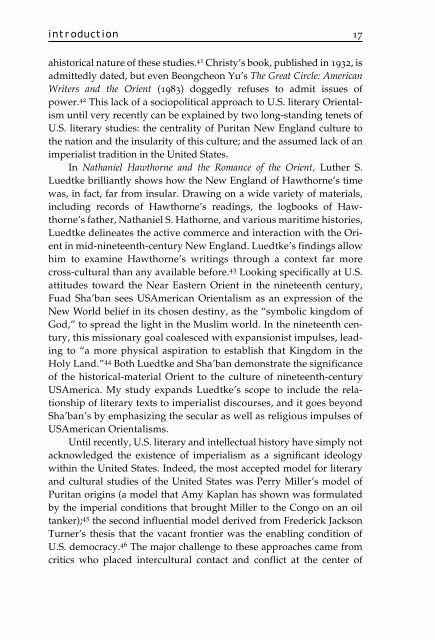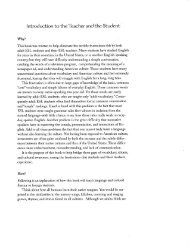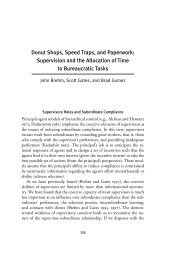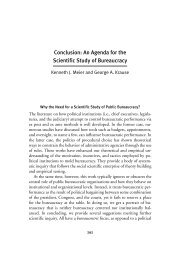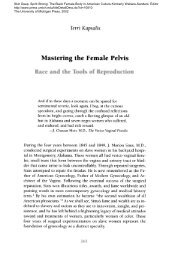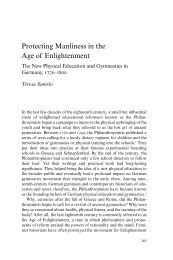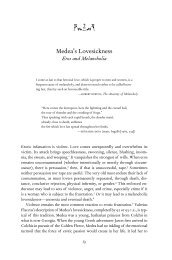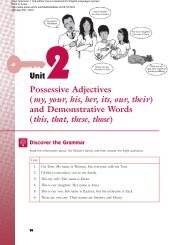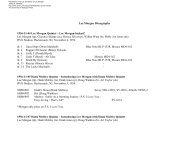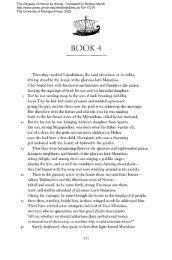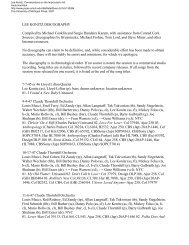Introduction - The University of Michigan Press
Introduction - The University of Michigan Press
Introduction - The University of Michigan Press
You also want an ePaper? Increase the reach of your titles
YUMPU automatically turns print PDFs into web optimized ePapers that Google loves.
introduction 17<br />
ahistorical nature <strong>of</strong> these studies. 41 Christy’s book, published in 1932, is<br />
admittedly dated, but even Beongcheon Yu’s <strong>The</strong> Great Circle: American<br />
Writers and the Orient (1983) doggedly refuses to admit issues <strong>of</strong><br />
power. 42 This lack <strong>of</strong> a sociopolitical approach to U.S. literary Orientalism<br />
until very recently can be explained by two long-standing tenets <strong>of</strong><br />
U.S. literary studies: the centrality <strong>of</strong> Puritan New England culture to<br />
the nation and the insularity <strong>of</strong> this culture; and the assumed lack <strong>of</strong> an<br />
imperialist tradition in the United States.<br />
In Nathaniel Hawthorne and the Romance <strong>of</strong> the Orient, Luther S.<br />
Luedtke brilliantly shows how the New England <strong>of</strong> Hawthorne’s time<br />
was, in fact, far from insular. Drawing on a wide variety <strong>of</strong> materials,<br />
including records <strong>of</strong> Hawthorne’s readings, the logbooks <strong>of</strong> Hawthorne’s<br />
father, Nathaniel S. Hathorne, and various maritime histories,<br />
Luedtke delineates the active commerce and interaction with the Orient<br />
in mid-nineteenth-century New England. Luedtke’s findings allow<br />
him to examine Hawthorne’s writings through a context far more<br />
cross-cultural than any available before. 43 Looking specifically at U.S.<br />
attitudes toward the Near Eastern Orient in the nineteenth century,<br />
Fuad Sha’ban sees USAmerican Orientalism as an expression <strong>of</strong> the<br />
New World belief in its chosen destiny, as the “symbolic kingdom <strong>of</strong><br />
God,” to spread the light in the Muslim world. In the nineteenth century,<br />
this missionary goal coalesced with expansionist impulses, leading<br />
to “a more physical aspiration to establish that Kingdom in the<br />
Holy Land.” 44 Both Luedtke and Sha’ban demonstrate the significance<br />
<strong>of</strong> the historical-material Orient to the culture <strong>of</strong> nineteenth-century<br />
USAmerica. My study expands Luedtke’s scope to include the relationship<br />
<strong>of</strong> literary texts to imperialist discourses, and it goes beyond<br />
Sha’ban’s by emphasizing the secular as well as religious impulses <strong>of</strong><br />
USAmerican Orientalisms.<br />
Until recently, U.S. literary and intellectual history have simply not<br />
acknowledged the existence <strong>of</strong> imperialism as a significant ideology<br />
within the United States. Indeed, the most accepted model for literary<br />
and cultural studies <strong>of</strong> the United States was Perry Miller’s model <strong>of</strong><br />
Puritan origins (a model that Amy Kaplan has shown was formulated<br />
by the imperial conditions that brought Miller to the Congo on an oil<br />
tanker); 45 the second influential model derived from Frederick Jackson<br />
Turner’s thesis that the vacant frontier was the enabling condition <strong>of</strong><br />
U.S. democracy. 46 <strong>The</strong> major challenge to these approaches came from<br />
critics who placed intercultural contact and conflict at the center <strong>of</strong>


